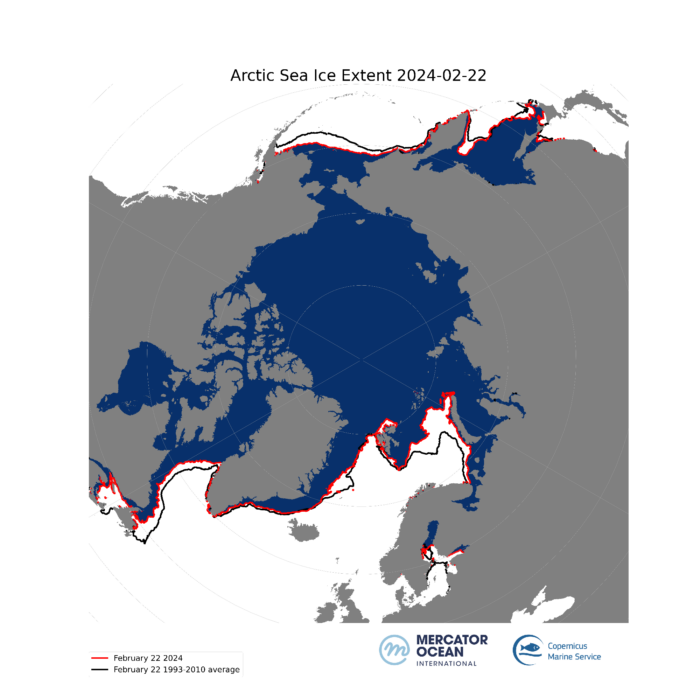
Key take-aways
- Sea ice extent in the Arctic is likely to have reached its annual maximum extent on 22 February, 4 % below the long-term average (1993-2010).
- Sea Ice volume is currently at 15.85 thousand km³, almost half the volume (45%) of winter ice has been lost compared with long-term average (1993-2010).
- February and early March 2024 remain one of the winters with the lowest sea ice extent and volume for the Arctic in recent decades.
Sea Ice Extent

On the 22nd of February 2024, the Arctic Sea ice concentration (figure 1 red line) was noticeably below the long-term average between 1993 and 2010 (figure 1 black line) for the same date in the year. Compared to the 1993-2010 period, large areas of sea ice cover are missing, particularly in the Barents Sea, which remains one of the polar regions where the impact of climate change is most pronounced (figure 1).


Arctic sea ice cover is likely to have reached its annual maximum extent of 14.5 million km² on 22February 2024. This represents a loss of 0.63 million km² compared to the 1993-2010 long term average (15.15 million km²), or 4.2 % less than this average period. February 2024 is one of the lowest estimates of the last 30 years.
Sea Ice Volume


The Arctic Sea ice volume has reached a volume of 15.85 thousand km³ on the 22nd of February 2024. This represents a deficit of 13.02 thousand km³ compared with the 1993-2010 long term average (28.87 thousand km3), or a loss of 45% in ice volume compared with this average period.
Arctic yearly maximum Sea Ice Extent
and Volume trends


During the annual winter maximum, the Arctic Sea ice cover shows a significant negative trend over the 1993-2024 period of 0.4 million km2 per decade for the sea ice extent and 4.7 thousand km3 per decade for the sea ice volume.
Definitions:
- Sea ice extent – area covered by a significant amount of sea ice, at least 15% sea ice concentration (km²).
- Sea ice concentration – percentage of sea ice cover within the data grid cell.
Notes:
This Mercator Ocean bulletin was developed by Clement Bricaud, Gilles Garric, and Gratianne Quade.
Products and data used: GLORYS12V1 global ocean eddy-resolving (1/12° horizontal resolution, 50 vertical levels) reanalysis covering the altimetry (1993 onward). https://doi.org/10.48670/moi-00021
The Operational Mercator global ocean analysis and forecast system at 1/12 degree. https://doi.org/10.48670/moi-00016
References:
Lellouche J.-M., Greiner E., Bourdalle-Badie R., Garric G., Melet A., Drévillon M., Bricaud C., Hamon, M., Le Galloudec O., Regnier C., Candela T., Testut C.-E., Gasparin F., Ruggiero G., Benkiran M., Drillet Y. and Le Traon P. Y., 2021. The Copernicus global 1/12° oceanic and sea ice GLORYS12 reanalysis. Front. Earth Sci., vol. 9, doi: 10.3389/feart.2021.698876 ; 2021 https://www.frontiersin.org/articles/10.3389/feart.2021.698876/abstract
Lellouche, J.-M., Greiner, E., Le Galloudec, O., Garric, G., Regnier, C., Drevillon, M., Benkiran, M., Testut, C.-E., Bourdalle-Badie, R., Gasparin, F., Hernandez, O., Levier, B., Drillet, Y., Remy, E., and Le Traon, P.-Y.: Recent updates to the Copernicus Marine Service global ocean monitoring and forecasting real-time 1∕12° high-resolution system, Ocean Sci., 14, 1093–1126, https://doi.org/10.5194/os-14-1093-2018, 2018.
Sebastian Gerland, Randi B. Ingvaldsen, Marit Reigstad, Arild Sundfjord, Bjarte Bogstad, Melissa Chierici, Haakon Hop, Paul E. Renaud, Lars Henrik Smedsrud, Leif Christian Stige, Marius Årthun, Jørgen Berge, Bodil A. Bluhm, Katrine Borgå, Gunnar Bratbak, Dmitry V. Divine, Tor Eldevik, Elena Eriksen, Ilker Fer, Agneta Fransson, Rolf Gradinger, Mats A. Granskog, Tore Haug, Katrine Husum, Geir Johnsen, Marius O. Jonassen, Lis Lindal Jørgensen, Svein Kristiansen, Aud Larsen, Vidar S. Lien, Sigrid Lind, Ulf Lindstrøm, Cecilie Mauritzen, Arne Melsom, Sebastian H. Mernild, Malte Müller, Frank Nilsen, Raul Primicerio, Janne E. Søreide, Gro I. van der Meeren, Paul Wassmann; Still Arctic?—The changing Barents Sea. Elementa: Science of the Anthropocene 5 January 2023; 11 (1): 00088. doi: https://doi.org/10.1525/elementa.2022.00088
*Image citation: European Union, Copernicus Marine Service Data 2024 I © Mercator Ocean
All images in this article can be used freely and should be cited with the information above.
More on the topic:
Antarctic Sea Ice Reaches Lows Never Before Observed – Mercator Ocean (mercator-ocean.eu)
